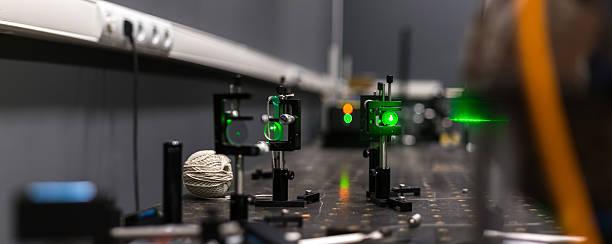All You Need to Know About Acousto-optic Q-switch Modulators: Function, Types, and Matching Drivers
Posté 2025-09-30 05:58:45
0
24

If you’re working with laser systems and need high-intensity pulsed light, acousto-optic Q-switch modulators are key components worth understanding. These devices operate directly inside laser cavities, generating intense laser pulses by actively controlling the cavity’s quality factor (Q factor, which relates to energy loss). Here’s how they work in simple terms: when an RF (radio frequency) signal is on, part of the laser cavity’s energy diffracts out of the cavity—this creates energy loss and stops the laser from oscillating. As soon as the RF signal turns off, the cavity’s loss drops quickly, and a strong laser pulse is emitted.
Key Things to Consider When Choosing an Acousto-optic Q-switch
Not all Q-switches are the same, so it’s important to focus on parameters that match your laser setup:
- Wavelength (to align with your laser’s output)
- Optical power density (to handle your laser’s power without damage)
- Polarization state (for consistent light interaction)
- Beam diameter (to fit your laser’s beam size)
- Diffraction efficiency (how well it controls light direction)
- Cooling mode (to manage heat and maintain performance)
Additionally, these Q-switches use unique, proprietary manufacturing and packaging technologies. This design optimizes heat dissipation and beam stability, making the products both durable and compact. For the best results, it’s recommended to use an acousto-optic driver specifically designed for Q modulation—this ensures perfect matching with your laser’s cavity length, repetition frequency, wavelength, optical aperture, polarization state, and output power.
Popular Acousto-optic Q-switch Series
Different laser wavelengths require specialized Q-switches. Here are three common series tailored to specific needs:
1. 10.6μm Acousto-optic Q-switch Series
Designed for laser cavities with a 10.6μm wavelength, this Q-switch relies on the interaction between ultrasonic waves and light. It offers high diffraction efficiency, enabling active Q modulation inside the laser cavity. To keep temperatures in check, it uses a water-cooled heat dissipation system—ideal for applications where consistent cooling is critical. Learn more about the 10.6μm Acousto-optic Q-switch Series.
2. 2.7μm Acousto-optic Q-switch Series
This series is built for 2.7μm laser cavities, also using the acousto-optic interaction principle. It stands out for its minimal insertion loss (meaning very little light is wasted as it passes through the device) and is made with high-quality fused quartz. A unique anti-reflection film adds extra value: it lets the Q-switch withstand extremely high laser power and provides excellent corrosion protection, ensuring long-term, reliable performance. Learn more about the 2.7μm Acousto-optic Q-switch Series.
3. 2μm Acousto-optic Q-switch Series
For 2μm laser cavities, this Q-switch uses acousto-optic interaction to achieve Q-switching. Like its counterparts, it generates high-intensity pulsed light by actively controlling the cavity’s Q factor (energy loss). It’s a straightforward, effective option for systems relying on 2μm laser wavelengths. Learn more about the 2μm Acousto-optic Q-switch Series.
Matching Acousto-optic Q-switch Drivers
To get the most out of your acousto-optic Q-switch, you’ll need a compatible RF driver. Two common driver types are designed to support different power needs:
V-type Acousto-optic Q-switch Driver
This RF driver is built to work with acousto-optic Q-switches that require less than 40W of driving power. It comes with useful features: digital modulation, analog modulation, and first pulse suppression. These functions help you better control beam modulation and shaping, ensuring your laser pulses meet your application’s requirements. Learn more about the V-type Acousto-optic Q-switch Driver.
W-type Acousto-optic Q-switch Driver
If your Q-switch needs up to 70W of driving power, the W-type driver is a better fit. It also uses digital and analog modulation, but with the flexibility to adjust input conditions. By tweaking these inputs, you can control key pulse characteristics—like pulse frequency, pulse width, and beam amplitude—tailoring the laser output to your specific needs. Learn more about the W-type Acousto-optic Q-switch Driver.
Whether you’re working on industrial laser processing, scientific research, or other laser-based applications, acousto-optic Q-switch modulators and their matching drivers provide a reliable way to generate high-intensity pulsed light. By choosing the right combination of Q-switch and driver, you can ensure your laser system operates efficiently and consistently.
Rechercher
Catégories
- Art
- Causes
- Crafts
- Dance
- Drinks
- Film
- Fitness
- Food
- Jeux
- Gardening
- Health
- Domicile
- Literature
- Music
- Networking
- Autre
- Party
- Religion
- Shopping
- Sports
- Theater
- Wellness
Lire la suite
Guía Completa para Comprar Currency en POE 2: Maximiza tus Recursos con Poe Quecholli
Guía Completa para Comprar Currency en POE 2: Maximiza tus Recursos con Poe Quecholli
En...
Medium Voltage Motors Market Growth, Size, and Trends Forecast 2025-2033
Market Overview:
The medium voltage motors market is experiencing rapid growth, driven by rising...
Cómo Obtener FIFA Coins y Monedas FC26 para Mejorar Tu Experiencia en EA FC 26
Cómo Obtener FIFA Coins y Monedas FC26 para Mejorar Tu Experiencia en EA FC 26...
Unlock the Ultimate Gaming Experience: How to Earn and Use FUT Coins, FIFA Coins, and FC 26 Coin Efficiently
Unlock the Ultimate Gaming Experience: How to Earn and Use FUT Coins, FIFA Coins, and FC 26 Coin...
Titre : "Comment effectuer un Top Up Honkai Star Rail : Guide pour Recharge HSR et Astuces pour Maximiser votre expérience de jeu
Comment effectuer un Top Up Honkai Star Rail : Guide pour Recharge HSR et Astuces pour...
© 2025 Scenario.press - libera espressione
 French
French


